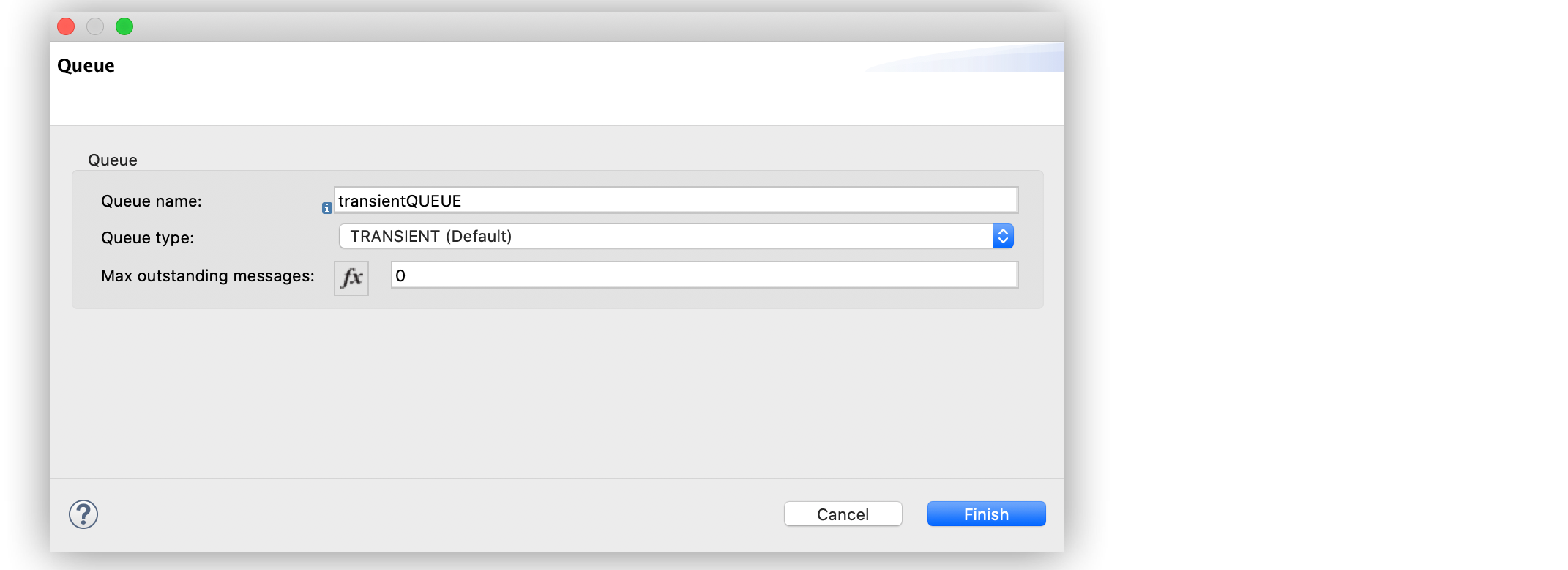
Using Anypoint Studio to Configure VM Connector 2.0
Anypoint Studio (Studio) editors help you design and update your Mule applications, properties, and configuration files.
To add and configure a connector in Studio:
When you run the connector, you can view the app log to check for problems, as described in View the App Log.
If you are new to configuring connectors in Studio, see Using Anypoint Studio to Configure a Connector. If, after reading this topic, you need additional information about the connector fields, see VM Connector Reference.
Create a Mule Project
In Studio, create a new Mule project in which to add and configure the connector:
-
In Studio, select File > New > Mule Project.
-
Enter a name for your Mule project and click Finish.
Add the Connector to Your Mule Project
Add VM Connector to your Mule project to automatically populate the XML code with the connector’s namespace and schema location and to add the required dependencies to the project’s pom.xml file:
-
In the Mule Palette view, click (X) Search in Exchange.
-
In the Add Dependencies to Project window, type
vm connectorin the search field. -
Click VM Connector in Available modules.
-
Click Add.
-
Click Finish.
Adding a connector to a Mule project in Studio does not make that connector available to other projects in your Studio workspace.
Configure a Source
A source initiates a flow when a specified condition is met. You can configure one of these input sources to use with VM Connector:
-
VM Listener, which initiates a flow by listening on a VM queue
-
HTTP Listener, which initiates a flow each time it receives a request on the configured host and port
-
Scheduler, which initiates a flow when a time-based condition is met
For example, to configure a VM Listener source, follow these steps:
-
In the Mule Palette view, select VM > Listener.
-
Drag Listener to the Studio canvas.
-
On the Listener configuration screen, optionally change the value of the Display Name field.
-
Click the plus sign (+) next to the Connector configuration field to configure a VM queue that can be used by all instances of the Listener source and other VM Connector operations in the app.
-
On the Listener configuration screen, set the Number of consumers field to your desired value (default is
4). -
In the Queue section, select a Queue name from the drop-down menu.
If you previously created a VM queue, the Queue name value appears automatically. -
Specify a value for the Timeout (default is
5). -
Select a Timeout unit from the drop-down menu.
Add a Connector Operation to the Flow
When you add a connector operation to your flow, you immediately define a specific operation for that connector to perform.
To add an operation for VM Connector, follow these steps:
-
In the Mule Palette view, select VM Connector and then select the desired operation.
-
Drag the operation onto the Studio canvas and to the right of the input source.
Configure a Global Element for the Connector
When you configure a connector, it’s best to configure a global element that all instances of that connector in the app can use. A VM Connector global configuration defines the queues on which the connector operates. You can define any number of configurations, each with its own set of queues.
Each queue defined within a given VM Connector configuration can be used only by operations referencing that specific configuration. A queue name cannot be repeated across configurations, and two queues with the same name can not exist in the same app or domain.
To configure the global element for VM Connector, follow these steps:
-
Select the name of the connector in the Studio canvas.
-
In the configuration screen for the operation, click the plus sign (+) next to the Connector configuration field to access the global element configuration fields.
-
In the General section, in the Queues drop-down menu select either:
-
Bean referenceIn the Bean reference field, add your desired reference value.
-
Edit inlineIn the Queues field, click the plus sign (+) to add a new queue. Then add a Queue name value, set Queue type to either
TRANSIENT (Default)orPERSISTENT, add a value for Max outstanding messages; and click Finish.
-
-
In the Connection section, optionally configure a reconnection strategy.
-
On the Advanced tab, optionally configure an expiration policy.
-
Click OK.
The following screenshot shows an example of configuring the VM Connector:

The following screenshot shows an example of configuring the VM queue:

In the XML editor, the VM Connector configuration looks like this:
<vm:config name="VM_Config">
<vm:queues>
<vm:queue queueName="transientQUEUE" queueType="TRANSIENT" />
<vm:queue queueName="persistentQUEUE" queueType="PERSISTENT" />
</vm:queues>
</vm:config>xmlView the App Log
To check for problems, you can view the app log as follows:
-
If you’re running the app from Anypoint Platform, the output is visible in the Anypoint Studio console window.
-
If you’re running the app using Mule from the command line, the app log is visible in your OS console.
Unless the log file path is customized in the app’s log file (log4j2.xml), you can also view the app log in the default location MULE_HOME/logs/<app-name>.log.



